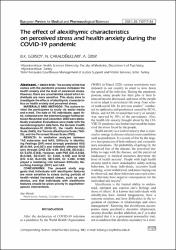| dc.contributor.author | Kurtses Gürsoy, Betül | |
| dc.contributor.author | Çakaloğulları, N | |
| dc.contributor.author | Üzer, Ahmet | |
| dc.date.accessioned | 2022-05-10T11:01:35Z | |
| dc.date.available | 2022-05-10T11:01:35Z | |
| dc.date.issued | 2021 | en_US |
| dc.identifier.citation | Gürsoy, B. K., Çakaloğullari, N., & Üzer, A. (2021). The effect of alexithymic characteristics on perceived stress and health anxiety during the COVID-19 pandemic. European review for medical and pharmacological sciences, 25(22), 7127-7134. | en_US |
| dc.identifier.issn | 1128-3602 | |
| dc.identifier.issn | 2284-0729 | |
| dc.identifier.uri | https://doi.org/10.26355/eurrev_202111_27266 | |
| dc.identifier.uri | https://hdl.handle.net/20.500.12933/966 | |
| dc.description.abstract | OBJECTIVE: The anxiety of life that comes with the pandemic process increases the health anxiety and the level of perceived stress. However, there are uncertainties about which individuals are more sensitive. This study aims to investigate the effects of alexithymic characteristics on health anxiety and perceived stress.
MATERIALS AND METHODS: The authors invited the participants to study via social media and e-mail. The data of 793 individuals, aged 18-65, collected over the internet (Google Forms) between November and December 2020 were statistically evaluated. Evaluations were made with the sociodemographic data form, the General Health Questionnaire-12 (GHQ-12), the Health Anxiety Scale (HAS), the Toronto Alexithymia Scale (TAS-20), and the Perceived Stress Scale (PSS).
RESULTS: In mediation analyzes between TAS subscales and HAS, Difficulty in Identifying Feelings (DIF) most strongly predicted HAS (B=0.469, p<0.001) and indirectly affected HAS only through GHQ (CS: 0.08, B=0.108, SE:0.021, CI: 0.070, 0.153). However, both PSS (CS: 0.0128, B=0.084, SE:0.027, CI: 0.032, 0.139) and GHQ (CS: 0.02, B=0.139, SE:0.028, CI: 0.090, 0.198) played a mediating role between Difficulty Describing Feelings (DDF) and HAS.
CONCLUSIONS: The present study suggests that individuals with alexithymic features are more sensitive to stress during periods of health-related increased stress, such as pandemics, and that individuals with alexithymic features should be given priority in psychotherapeutic interventions. | en_US |
| dc.language.iso | eng | en_US |
| dc.publisher | Verduci | en_US |
| dc.relation.isversionof | 10.26355/eurrev_202111_27266 | en_US |
| dc.rights | info:eu-repo/semantics/openAccess | en_US |
| dc.subject | Alexithymia | en_US |
| dc.subject | Anxiety | en_US |
| dc.subject | Covidien | en_US |
| dc.subject | Pandemics | en_US |
| dc.title | The effect of alexithymic characteristics on perceived stress and health anxiety during the COVID-19 pandemic | en_US |
| dc.type | article | en_US |
| dc.authorid | 0000-0002-1261-0848 | en_US |
| dc.authorid | 0000-0003-2830-931X | en_US |
| dc.department | AFSÜ, Tıp Fakültesi, Dahili Tıp Bilimleri Bölümü, Ruh Sağlığı ve Hastalıkları Ana Bilim Dalı | en_US |
| dc.contributor.institutionauthor | Kurtses Gürsoy, Betül | |
| dc.contributor.institutionauthor | Üzer, Ahmet | |
| dc.identifier.volume | 25 | en_US |
| dc.identifier.issue | 22 | en_US |
| dc.identifier.startpage | 7127 | en_US |
| dc.identifier.endpage | 7134 | en_US |
| dc.relation.journal | European Review for Medical and Pharmacological Sciences | en_US |
| dc.relation.publicationcategory | Makale - Uluslararası Hakemli Dergi - Kurum Öğretim Elemanı | en_US |
















